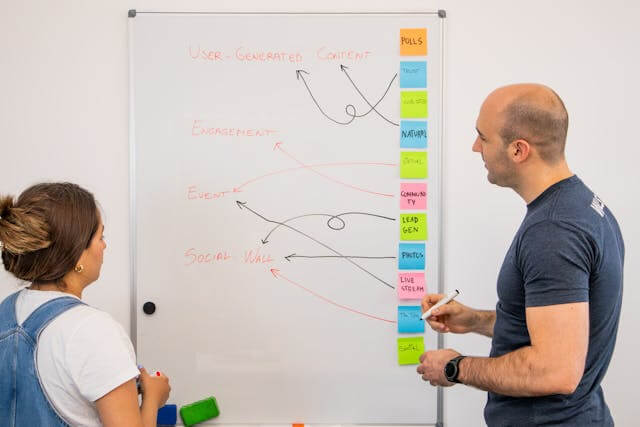In my decade of helping tech firms generate B2B leads across Africa, Europe, and the Middle East, one thing has become painfully clear, many companies don’t have a lead generation problem. They have a strategy problem. They’re pouring time and money into campaigns that don’t convert because they’re making fundamental B2B lead generation mistakes that quietly kill their results.
If you’re running a tech firm and struggling to bring in qualified B2B leads, this article is for you. I’ve compiled the top 10 B2B lead generation mistakes I see tech companies make repeatedly and more importantly, how to avoid each one.
By the end of this post, you’ll not only know where the leaks in your funnel are, but you’ll also walk away with proven strategies to fix them.
Let’s dive in.
1. Not Defining a Clear Ideal Customer Profile (ICP)
This is the root of many other mistakes. If you don’t know exactly who you’re targeting, your messaging, offers, and content will fall flat.
Tech firms often say they target “enterprise clients” or “mid-sized businesses.” That’s too broad. You need to get specific.
Define:
- Industry and sub-industry
- Job titles of decision-makers
- Tech stack they currently use
- Pain points unique to their operations
In one project, we helped a SaaS company refine their ICP from “healthcare businesses” to “hospital administrators managing internal data security in Sub-Saharan Africa.” That clarity doubled their lead-to-demo conversion rate in just 60 days.
2. Relying Too Much on Paid Ads Without Solid Content
Many tech firms throw money at paid ads before building any real content strategy. The result? Clicks but no conversions.
Paid ads can drive traffic, but without valuable content to nurture that traffic, your funnel will leak at every stage. In 2025, B2B buyers want education, not interruption.
A better approach is to create high-value content, whitepapers, industry guides, comparison pages and then amplify those with paid campaigns. This builds trust before your sales team even makes contact.
Also Read: Using Intent Data to Attract High-Quality B2B Leads in 2025
3. Treating All Leads the Same Way
Not every lead is ready to buy. But too many tech companies drop leads into a one-size-fits-all follow-up sequence.
You need to segment leads by intent and engagement level.
Someone who downloaded a pricing sheet is far more sales-ready than someone who watched a general webinar. Your approach should reflect that.
Marketing automation and CRM tools can help you personalize your sequences. The more tailored your follow-up, the higher your close rate.
4. Ignoring Intent Data Signals
Intent data tells you what your prospects are researching in real time. Ignoring it means you’re missing out on hot leads.
In a recent campaign, we used Bombora to identify companies researching “zero-trust architecture” in East Africa. This intel helped us craft personalized emails and LinkedIn outreach, leading to a 37% increase in booked demos in just two months.
If you’re not using intent data in 2025, you’re basically walking into a pitch blind.
5. Poorly Optimized Landing Pages
It doesn’t matter how good your ad or email copy is, if your landing page is slow, unclear, or irrelevant, leads won’t convert.
I often see pages that:
- Try to do too much
- Bury the value proposition below the fold
- Ask for too much information upfront
Your landing page should answer one key question: “What’s in it for me?” Make it specific, relevant, and skimmable. And test it relentlessly.
Also Read: 10 Best B2B Lead Generation Strategies That Work for Complex Enterprise Solutions
6. Overcomplicating the Funnel
I’ve seen funnels with 15 steps before a lead can even talk to a sales rep. That’s overkill.
While enterprise tech buyers do go through longer journeys, adding unnecessary friction only drives them away. Keep the path to conversion clear. Remove any steps that don’t directly add value.
Sometimes, a simple path from ad → lead magnet → demo request works better than a fancy multi-step nurture campaign.
7. Not Aligning Sales and Marketing
If your marketing team is generating leads, but your sales team isn’t closing them, there’s a disconnect.
This happens when:
- Marketing doesn’t understand what sales considers a “qualified lead”
- Sales isn’t following up quickly or effectively
- Feedback between the teams is rare or non-existent
Fix this by having shared KPIs, regular pipeline reviews, and clear lead scoring criteria. Your B2B lead generation only works when sales and marketing are rowing in the same direction.
8. Forgetting About Lead Nurturing
Only a small percentage of B2B leads are ready to buy right away. But many tech firms give up after one or two emails.
According to HubSpot, 80% of B2B deals require at least five follow-ups, yet 44% of reps give up after the first.
Use email sequences, retargeting ads, and valuable content to stay in touch with leads over time. Keep the conversation going, even when they’re not ready to buy.
9. Failing to Track the Right Metrics
Many tech companies track vanity metrics: likes, impressions, email opens, but ignore what really matters: lead quality, opportunity pipeline, close rate, and customer lifetime value.
You can’t improve what you don’t measure.
Set up dashboards that highlight:
- Cost per qualified lead
- Time from lead to demo
- Close rates by source
Then use those insights to double down on what works.
Also Read: How to Build a High-Converting B2B Lead Funnel for Enterprise Tech Companies
10. Giving Up Too Soon
This is a mindset issue. B2B lead generation, especially in tech, isn’t a one-and-done activity. It takes time, testing, and iteration.
Too often, I see founders ditch a campaign after two weeks of underwhelming results. In reality, that’s not enough time to gather meaningful data.
Commit to a long-term strategy. Refine as you go. And always talk to your customers to improve your targeting and messaging.
How I Fixed Mistake No. 3 for a SaaS Startup in Lagos
In 2022, I consulted with a Nigerian SaaS startup offering workflow automation for HR teams. They had a great product and decent traffic. However, they were struggling to convert leads into paying users.
Their mistake? They treated every lead the same.
Whether someone downloaded a blog checklist or requested a demo, they all received the same email sequence. There was no personalization based on behavior or stage of interest.
We made three key changes:
- Introduced a lead scoring model based on activity and job title.
- Built two nurture tracks, one for early-stage prospects, another for sales-ready leads.
- Aligned sales and marketing to prioritize the top 10% of hot leads each week.
Within 90 days, demo bookings increased by 62%. More importantly, they saw a 3x improvement in lead-to-customer conversion rates.
It wasn’t magic. It was simply fixing a process that was misaligned with buyer behavior.
Final Thoughts: Build Smarter, Not Louder
Avoiding these B2B lead generation mistakes isn’t just about saving money—it’s about protecting your time, reputation, and momentum.
Tech firms are innovating fast, but lead generation must keep up. In 2025, the firms that win will be the ones that:
- Know their audience deeply
- Personalize their outreach
- Align sales and marketing
- Use data to make smarter decisions
You don’t need more noise. You need precision.



